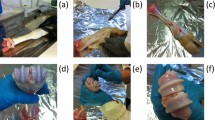Abstract
Background
Since articular cartilage has important mechanical properties such as load-bearing, shock absorption and lubrication for activities in daily life, it is important to evaluate the mechanical properties of repaired cartilage in terms of whether those properties are the same as those of natural cartilage. The purpose of this study was to investigate the effectiveness of an electrical impedance method for quantitatively measuring the mechanical properties of cartilage.
Methods
Cartilage specimens were harvested from porcine knee joint, and two kinds of enzyme-treated cartilages were prepared to investigate the correlation between mechanical and electrical properties resulting from changes in the structure of the extracellular matrix. Collagenase solution and hyaluronidase solution were used to digest the collagen fibril and proteoglycan, respectively. Electrical impedance measurement, indentation test and biochemical analysis were carried out for the enzyme-treated cartilages.
Results
The water content increased with enzyme treatment time, and the permeability of the treated cartilages increased with decreasing glycosaminoglycan content for both types of enzyme-treated cartilages. The aggregate modulus and the electrical resistivity for both types of enzyme-treated cartilages decreased with increasing permeability after 12-h treatment. The aggregate modulus and the electrical resistivity for both types of treated cartilages decreased with increasing water content and permeability after 24-h treatment. The electrical resistivity and the aggregate modulus of articular cartilage depended not only on the water content, but also on the permeability, and the electrical resistivity for both types of enzyme-treated cartilages was found to be significantly linearly correlated with the aggregate modulus.
Conclusions
These results showed that the aggregate modulus of articular cartilage can be estimated by measuring its electrical impedance.







Similar content being viewed by others
References
Aoki H, Tomita N, Morita Y, Hattori H, Harada Y, Sonobe M, Wakitani S, Tamada Y. Culture of chondrocytes in fibroin-hydrogel sponge. Bio-Med Mater Eng. 2003;13:309–16.
Brittberg M, Nilsson A, Lindahl A, Ohlsson C, Peterson L. Rabbit articular cartilage defects treated with autologous cultured chondrocytes. Clin Orthop Relat Res. 1996;326:270–83.
Jortikka MO, Parkkinen JJ, Inkinen RI, Kärner J, Järveläinen HT, Nelimarkka LO, Tammi MI, Lammi MJ. The role of microtubules in the regulation of proteoglycan synthesis in chondrocytes under hydrostatic pressure. Arch Biochem Biophys. 2000;374:172–80.
Kawamura S, Wakitani S, Kimura T, Maeda A, Caplan AI, Shino K, Ochi T. Articular cartilage repair. Acta Orthop Scand. 1998;69:56–62.
Mizuno S, Ushida T, Tateishi T, Glowachi J. Effects of physical stimulation on chondrogenesis in vitro. Mater Sci Eng C. 1998;6:301–6.
Smith RL, Donlon BS, Gupta MK, Mohtai M, Das P, Carter DR, Cooke J, Gibbons G, Hutchinson N, Schurman DJ. Effects of fluid-induced shear on articular chondrocyte morphology and metabolism in vitro. J Orthop Res. 1995;13:824–31.
Wakitani S, Goto T, Young RG, Mansour JM, Goldberg VM, Caplan AI. Repair of large full-thickness articular cartilage defects with allograft articular chondrocytes embedded in a collagen gel. Tissue Eng. 1998;4:429–44.
Morita Y, Tomita N, Aoki H, Wakitani S, Tamada Y, Suguro T, Ikeuchi K. Visco-elastic properties of cartilage tissue regenerated with fibroin sponge. Bio-Med Mater Eng. 2002;12:291–8.
Morita Y, Tomita N, Aoki H, Wakitani S, Tamada Y, Suguro T, Ikeuchi K. Evaluation of dynamic visco-elastic properties during cartilage regenerating process in vitro. Bio-Med Mater Eng. 2003;13:345–53.
Basalo IM, Mauck RL, Kelly TA, Nicoll SB, Chen FH, Hung CT, Ateshian GA. Cartilage interstitial fluid load support in unconfined compression following enzymatic digestion. J Biomech Eng. 2004;126:779–86.
Chen AC, Nguyen TT, Sah RL. Streaming potentials during the confined compression creep test of normal and proteoglycan-depleted cartilage. Ann Biomed Eng. 1997;25:269–77.
Changoor A, Coutu JP, Garon M, Quenneville E, Hurtig MB, Buschmann MD. Streaming potential-based arthroscopic device is sensitive to cartilage changes immediately post-impact in an equine cartilage injury model. J Biomech Eng. 2011;133:061005.
Dean DA, Ramanathan T, Machado D, Sundararajan R. Electrical impedance spectroscopy study of biological tissues. J Electrost. 2008;66:165–77.
Sierpowska J, Lammi MJ, Hakulinen MA, Jurvelin JS, Lappalainen R, Töyräs J. Effect of human trabecular bone composition on its electrical properties. Med Eng Phys. 2007;29:845–52.
Poole AR. Proteoglycans in health and disease: structures and functions. Biochem J. 1986;236:1–14.
Burstein D, Gray ML, Hartman AL, Gipe R, Foy BD. Diffusion of small solutes in cartilage as measured by nuclear magnetic resonance spectroscopy and imaging. J Orthop Res. 1993;11:465–78.
Torzilli PA, Arduino JM, Gregory JD, Bansal M. Effect of proteoglycan removal on solute mobility in articular cartilage. J Biomech. 1997;30:895–902.
Gu WY, Justiz MA. Apparatus for measuring the swelling dependent electrical conductivity of charged hydrated soft tissues. J Biomech Eng. 2002;124:790–3.
Gu WY, Justiz MA, Yao H. Electrical conductivity of lumbar anulus fibrosis: effects of porosity and fixed charge density. Spine. 2002;27:2390–5.
Frank E, Evans R, Lee C, Treppo S, Spector M, Grodzinsky A. Quantitative electrical impedance analysis of cartilage degradation. Biorheology. 2004;41:195–202.
Mak AF, Lai WM, Mow VC. Biphasic indentation of articular cartilage—I. Theoretical analysis. J Biomech. 1987;20:703–14.
Mow VC, Gibbs MC, Lai WM, Zhu WB, Athanasiou KA. Biphasic indentation of articular cartilage-II. A numerical algorithm and an experimental study. J Biomech. 1989;22:853–61.
Farndale RW, Buttle DJ, Barrett AJ. Improved quantitation and discrimination of sulphated glycosaminoglycans by use of dimethylmethylene blue. Biochim Biophys Acta. 1986;883:173–7.
Korhonen RK, Laasanen MS, Töyräs J, Lappalainen R, Helminen HJ, Jurvelin JS. Fibril reinforced poroelastic model predicts specifically mechanical behavior of normal, proteoglycan depleted and collagen degraded articular cartilage. J Biomech. 2003;36:1373–9.
Acknowledgments
We would like to thank Naoya Nitta, Takashi Goto, and Yuya Sato for their assistance with data acquisition.
Conflict of interest
The authors have no conflicts of interest to disclosure.
Author information
Authors and Affiliations
Corresponding author
About this article
Cite this article
Morita, Y., Kondo, H., Tomita, N. et al. A feasibility study for evaluation of mechanical properties of articular cartilage with a two-electrode electrical impedance method. J Orthop Sci 17, 272–280 (2012). https://doi.org/10.1007/s00776-012-0208-x
Received:
Accepted:
Published:
Issue Date:
DOI: https://doi.org/10.1007/s00776-012-0208-x




